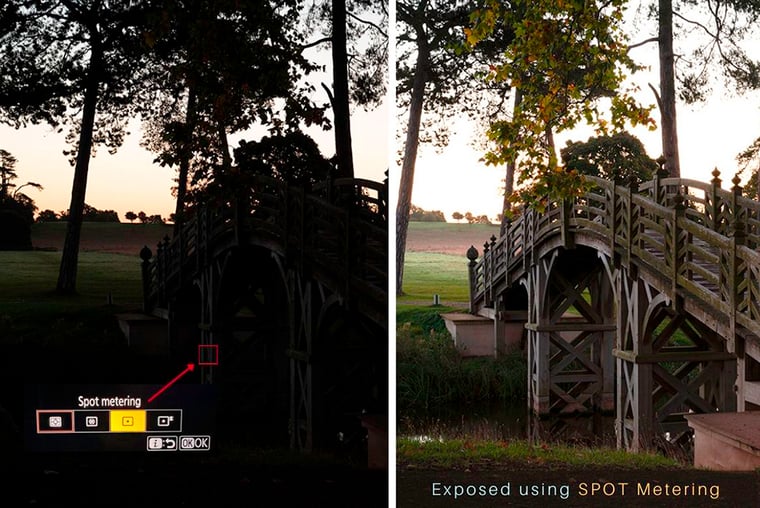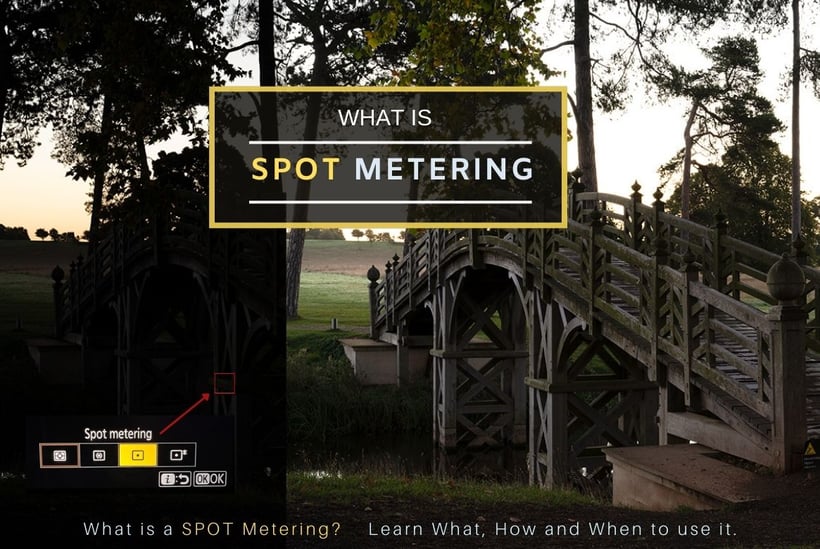What is Spot Metering: Everything You Need to Know
Camera Metering modes can vary from model to model and with the continual development work by manufactures more sophisticated methods appear year on year in the way of Smart Metering modes. These complexed modes have their place to aid the photographer by using the latest technology to improve the cameras ability to accurately match its meter reading to what is in the frame.
However it is important for a photographer to have full control of their camera to be creative and produce images as they intended and why the original basic modes one being Spot Metering are selectable.
The four basic mode types available are Average, Center Weighted, Center Circle and Spot Metering and it is essential to understand these to get the perfect exposure every photograph you take. In this post we will focus on What is Spot Metering? How and when to use it and help you nail those perfectly exposed images every time.

What is Spot Metering?
When Spot metering mode is selected on you camera it uses a small circle usually between 1% and 2% of the entire frame to calculate and suggest the correct exposure. The cameras built in light meter measures the amount of light being reflected off the subject and calculates the exposure value based on the brightness of the subject and the camera ISO setting.
On most advanced DSLR cameras these days you have the ability to tell the camera exactly where to measure the exposure within a scene and is centered on the current focus point. It is important to note that when using single point focus that the Spot Metering area is larger than the single focus point and metering is not just confined to the focused area.
If your camera does not have the functionality to move the spot and is locked centered you can get around this by aiming off centering the desired tone in the scene you want to meter and then locking the exposure (usually by keeping the shutter release half pressed) and re-framing.

When to use Spot Metering
You should consider using Spot Metering if your subject within the frame is strongly backlit. This will tell the camera to take a meter reading off of the subject and only off the subject that is within the area of the spot.
For example your subject is a person standing in front of a bright backdrop such as a bright white wall. In Average mode the camera would measure the entire scene and try to adjust the exposure information so that the wall was better exposed by darkening it. If you exposed the scene using this information from the camera your subject would be under exposed.
However using Spot Metering placed on your subject would give more accurate exposure information based purely off the person confined within the area of the spot ignoring the bright wall behind.
Situations where you should consider using Spot metering mode include:
- Strongly backlit subjects that are resulting in the subject being underexpose
- Snow or sunny beach environments where the brightness of the scene could fool the camera meter
- Wildlife photography where a bird is inflight against a bright sky or clouds
- When you feel the overall feel of the photograph is too bright or dark

How digital camera metering modes work
When Spot Metering is selected the camera meter averages all of the brightness values within it small circle (spot) to determine a middle tone often referred to as 18 percent grey. The camera then determine the exposure based on this middle grey value which is very important to understand. The easiest way to get to grips with what your camera is doing is to remember that it would under expose a white wall and over expose a black wall in an attempt to make them appear grey.
Using metering modes can cause havoc and be confusing to the less experienced photographer when shooting very high key images such as a snow scene. Your images can appear dull and grey when your camera meter is telling you that you have the perfect exposure. This is where exposure compensation comes in to combat this to tell the camera to over or under expose by a defined amount of stops depending on the scene you are shooting.
Use Spot Metering to get the perfect subject exposure in bright scenes
Hopefully this blog post has given you valuable information explaining what is Spot Metering, how to use it and when. Understanding the different camera meeting modes and knowing exactly when to use spot metering will enable to nail those perfect exposures in challenging scenarios.
Remember above all your camera is a tool and the best way to master it is to use it so get out and have fun!
If you would like to read more blog post like this one checkout my Landscape Photography Blog
Popular Camera Manufacture Metering mode links
Useful links for further information/manuals on Camera Metering modes by popular Camera Manufactures
- Nikon Camera Metering Modes
- Canon Camera Metering Modes
- Sony Camera Metering Modes
- Fuji Camera Metering Modes
With years of experience and a number of award winning photographs Nigel Waters is a UK landscape photographer based in Worcestershire. With a passion for the great outdoors and continually chasing the light to capture beautiful photographs his landscape, seascape and nightscape photography will give you inspiration to get out and explore the best British landscapes have to offer.



May 29, 2024 @ 9:15 am
Thank you so much for this precise (and concise) explanation of spot metering – including the helpful inset to clarify the camera’s spot meter setting.
June 1, 2024 @ 2:47 pm
Hi James, thanks for the comments. It is always good to hear when someone finds my posts informative and useful.